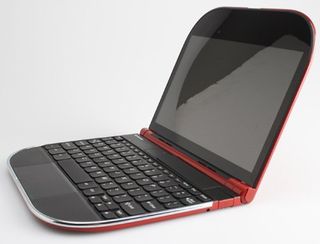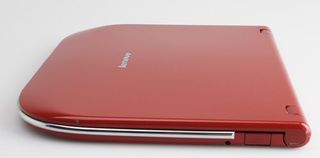Lenovo Skylight Hands-On: Sexy Device Could Propel Smartbook Category

Ever since we first heard about smartbooks we've been intrigued, but skeptical. A brand new category of ultraportable notebook, smartbooks feature ARM-based processors, Linux operating systems, superthin designs, incredible battery life, and optional 3G connections. They seek to fulfill the original goal of netbooks, providing extremely portable, inexpensive Internet devices that sit between a smart phone and a full-fledged PC.
Without having laid eyes on a working smartbook, we wondered: who will want one of these devices? Won't users demand a fully-functional Windows computer, just as they did when they first started using Linux netbooks, like the original Eee PC?
Today we got a few minutes of hands-on time with the Lenovo Skylight, the first smartbook we've seen from a major notebook vendor, and it was a revelation. If the production units live up to the promise of the demo we played with, this delicious device could have enough sex appeal to propel the entire smartbook category into the mainstream.
Lenovo Skylight Design
Our photos and video simply cannot replicate just how beautiful this notebook is when seen in-person. The first thing we noticed were the stunning shades of both the red and blue units (a silver model will also be available). Looking at the rounded lids, the red and blue Skylights look like finely glazed sculptures.

The view from the side is even more stunning as you notice that the device is only about 17mm thick, making it one of the thinnest notebooks on the market and, at under 2 pounds, one of the lightest. Despite the thinness, Lenovo says the Skylight should remain cool in normal use. Our Lenovo rep told us he had been using the blue unit all day long and, when we touched the keyboard, touchpad, deck, and bottom, we felt no heat at all. We'll withhold final judgement until we can get a Skylight in our office and run on a serious heat test on it.
Awesome Keyboard, Huge Touchpad
Stay in the know with Laptop Mag
Get our in-depth reviews, helpful tips, great deals, and the biggest news stories delivered to your inbox.
The highly-responsive, island-style keyboard on the Lenovo Skylight is exactly the same one used on the ThinkPad Edge 13 and ThinkPad X100e, just without a TrackPoint. Simply put, this might be the best keyboard in use today; it's certainly up there, because the keys have just the right amount of space between them and they provide a tone of tactile feedback. To see such a great keyboard on such a tiny device is truly impressive.

The touchpad is very wide for a device this size, though on the demo unit it was a bit jumpy. Our Lenovo rep said they are still working to finalize the touchpad. Instead of distinct mouse buttons, you have to click the pad itself to the left or right. We've seen this design before on MacBooks and on the HP Envy 15 and normally we prefer discrete buttons.
Lots of Ports
The Skylight packs an interesting array of ports into its tiny chassis. It comes with both micro SD and full SD card reader slots, an audio port, and a mini HDMI port, and a USB port. There's a SIM card slot for connecting to 3G networks too. Most interesting, though, is the second USB port which sits on the deck, above the keyboard, and holds aUSB flash drive that serves as the Skylight's storage device.
In lieu of a hard drive of internal SSD, all of a user's data -- from their MP3s and photos to their browser cache files and stored passwords sits on this removable flash drive. However, the OS and software live on an internal 8GB SSD that the user cannot modify. Hence, a user could remove the flash drive and pop it into another Lenovo Skylight smartbook and that Skylight would immediately have all of that user's files and preferences.
Skylight UI
The Skylight does not run Windows, but instead sports the "Lenovo Skylight" operating system. Built on top of a Linux kernel, Skylight is a very simple, but powerful front end for accessing media files, the Web, and popular Web services like Twitter, FaceBook, and YouTube.
The Skylight home screen consists of 3 screens with 6 "gadgets" (aka apps) on each. The gadgets appear on the desktop as small windows that you can either interact with or expand to full screen. A dock, containing shortcuts for each app, appears at the bottom of the screen as well. Right now there are only 18 apps, but they cover a wide range of functions from Firefox Web browsing (with Flash 10 support built-in), to YouTube, Facebook, Twitter, photo viewing, and media playback.
The interface is incredibly clean and attractive. The dock reminded us of Mac OS X, while the gadget squares reminded us a bit of Google Andoid gadgets. However, the colors and layout seem of the Skylight OS seem fresh and original. Lenovo says it will release an SDK and work to get third party developers building gadgets in the near future.
Early Verdict
The Skylight won't replace your primary Windows or Mac notebook. However, it is so thin, light, attractive, and functional that it makes a compelling case for itself. It's supposed to last 10 hours on a charge and over 60 hours when asleep. So users can carry it around like a smart phone, never shutting it off, but rather putting it to sleep until they need it next. We think the Skylight could be a great system for people who like to tweet and blog, because the keyboard / screen are much more conducive to content-creation than those on a smart phone. Perhaps we'll see a raft of tech journalists blogging from their smartbooks at CES 2011 and, if so, the Skylight could be the match that started the fire.
Check out our video below to get a closer look at the Lenovo Skylight in action.
[flq:9822e2b0e18440e79dc9a7d66b5d8852]

